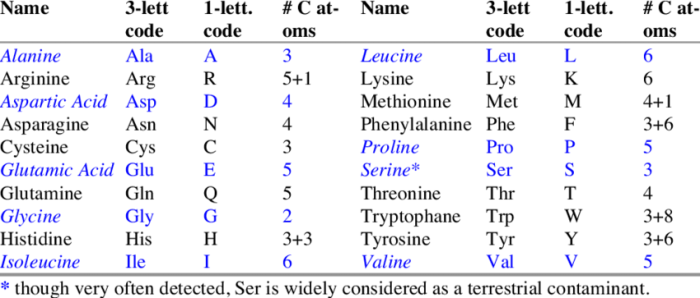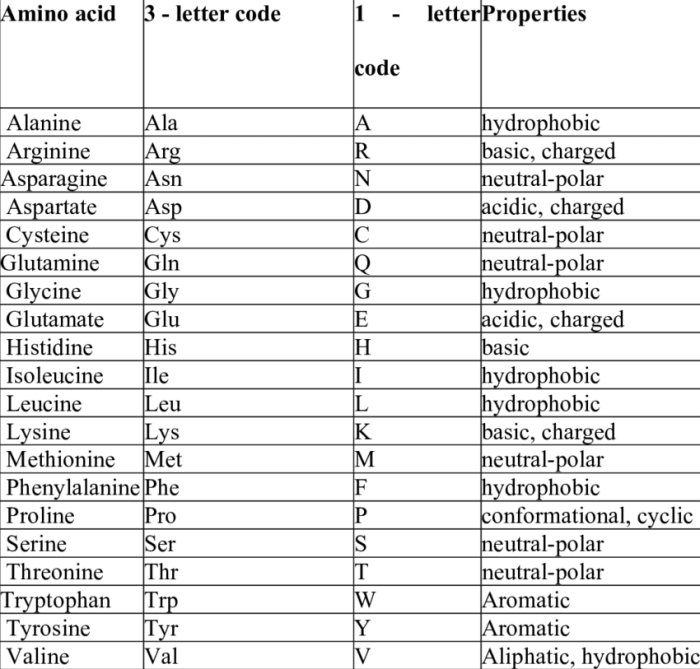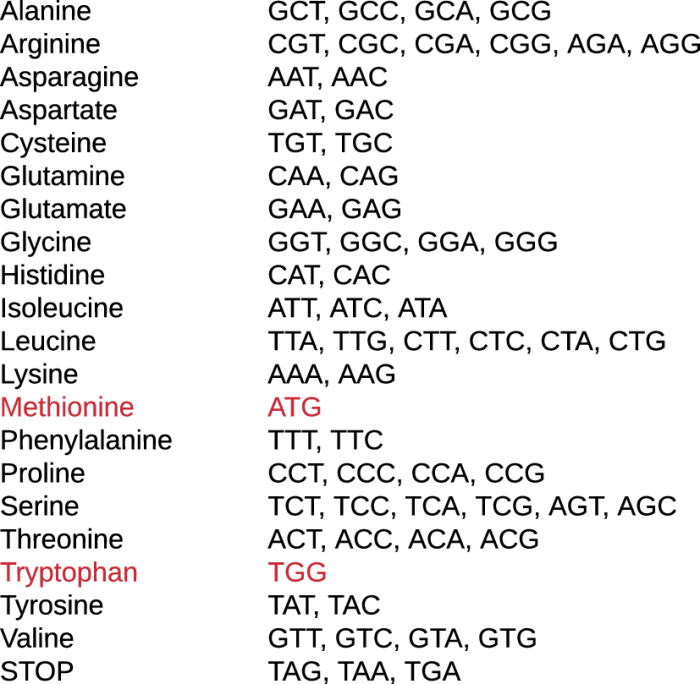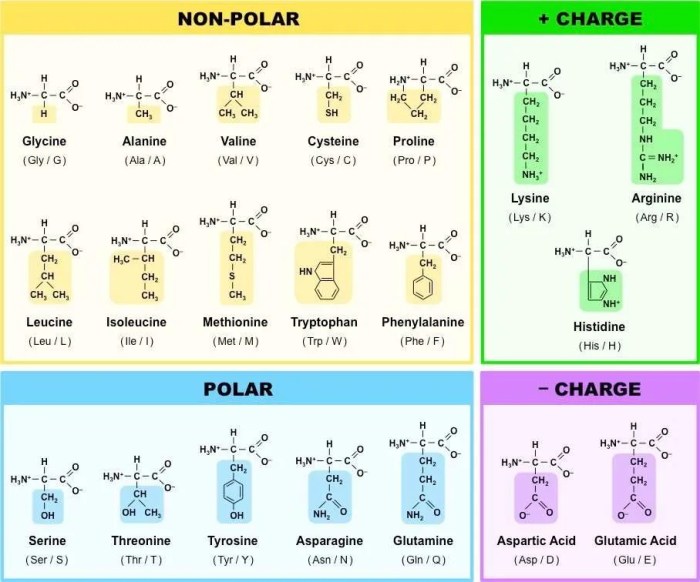In the realm of molecular biology, the amino acid quiz one letter code stands as a cornerstone, offering a concise and efficient way to represent the building blocks of proteins. This guide delves into the purpose, usage, and applications of these codes, providing a comprehensive understanding of their significance in the field.
From deciphering protein sequences to unraveling the complexities of protein structure, one-letter codes play a pivotal role in advancing our knowledge of the molecular world. Join us as we explore the fascinating world of amino acid codes, uncovering their versatility and impact on the field of bioinformatics.
Amino Acid One-Letter Codes

One-letter codes are single-letter abbreviations used to represent amino acids in protein sequences. These codes are widely accepted and used in various fields of biology, including biochemistry, molecular biology, and genetics.
The table below lists the 20 standard amino acids and their corresponding one-letter codes.
Table of Standard Amino Acids and One-Letter Codes
| Amino Acid | One-Letter Code |
|---|---|
| Alanine | A |
| Arginine | R |
| Asparagine | N |
| Aspartic acid | D |
| Cysteine | C |
| Glutamic acid | E |
| Glutamine | Q |
| Glycine | G |
| Histidine | H |
| Isoleucine | I |
| Leucine | L |
| Lysine | K |
| Methionine | M |
| Phenylalanine | F |
| Proline | P |
| Glutamine | Q |
| Serine | S |
| Threonine | T |
| Tryptophan | W |
| Tyrosine | Y |
| Valine | V |
Abbreviations and Notations

One-letter codes for amino acids are widely used in conjunction with abbreviations and notations to facilitate efficient communication and data management in biochemistry and related fields.
For instance, sequences of amino acids can be represented using one-letter codes, with the entire sequence enclosed in brackets. Modifications to amino acids, such as phosphorylation or glycosylation, can be indicated using specific symbols or abbreviations.
Amino Acid Sequence Abbreviations
Amino acid sequences can be represented using one-letter codes enclosed in brackets. For example, the sequence of the tripeptide glycine-alanine-serine can be written as [GAS].
Amino Acid Modification Abbreviations
Specific symbols or abbreviations are used to indicate modifications to amino acids. For example, phosphorylation of a serine residue is denoted by “pSer” or “S(P)”, while glycosylation of an asparagine residue is represented by “N(GlcNAc)” or “Asn-GlcNAc”.
Applications in Bioinformatics: Amino Acid Quiz One Letter Code

One-letter codes play a pivotal role in bioinformatics, providing a concise and standardized way to represent amino acids in computational analyses. These codes facilitate efficient data storage, processing, and exchange within databases and software applications.
Sequence Analysis, Amino acid quiz one letter code
One-letter codes enable rapid and accurate sequence comparisons, allowing researchers to identify similarities and differences between protein sequences. This information is crucial for studying protein evolution, function, and interactions.
Protein Structure Prediction
One-letter codes are utilized in protein structure prediction algorithms to represent the amino acid sequence of a protein. These algorithms use the codes to determine the most likely three-dimensional structure of the protein, which is essential for understanding its function.
Database Searches
One-letter codes are widely used in database searches to retrieve information about specific proteins. By entering the one-letter code of an amino acid into a database, researchers can quickly find proteins that contain that particular amino acid or sequence.
Advantages and Limitations

Using one-letter codes for amino acids offers both advantages and limitations in the representation of amino acids. Understanding these aspects is essential for effective communication and data analysis in the field of bioinformatics.
For a quick refresher on amino acid quiz one letter codes, check out gateways to art third edition for an informative and interactive guide. This resource offers a comprehensive overview of the topic, ensuring you’ll ace your next amino acid quiz.
Advantages
- Conciseness:One-letter codes provide a compact and efficient way to represent amino acids, allowing for easy storage and processing of large datasets.
- Standardization:The use of a standardized set of one-letter codes ensures consistency in amino acid representation across different platforms and applications.
- Compatibility:One-letter codes are widely accepted and compatible with various bioinformatics tools and databases, facilitating data exchange and analysis.
- Speed:The brevity of one-letter codes allows for faster processing and searching algorithms, particularly in large-scale datasets.
Limitations
- Ambiguity:Some amino acids have multiple one-letter codes, which can lead to ambiguity in certain contexts. For example, both ‘U’ and ‘C’ represent cysteine.
- Lack of Information:One-letter codes provide limited information about the specific properties and characteristics of amino acids, which may be necessary for certain applications.
- Potential for Confusion:The use of single letters can potentially lead to confusion, especially when working with long sequences or complex datasets.
- Limited Context:One-letter codes do not provide any context about the amino acid’s position or role within a protein structure.
Historical Perspective

The development of one-letter codes for amino acids has its roots in the early days of biochemistry.
In the 1950s, as scientists began to unravel the structure and function of proteins, they recognized the need for a shorthand way to represent the 20 different amino acids that make up these molecules. Initially, various three-letter codes were used, but these were cumbersome and difficult to remember.
One-Letter Codes
In 1968, a group of biochemists led by Margaret Dayhoff proposed a set of one-letter codes for amino acids. These codes were based on the first letter of the amino acid’s name, or in some cases, the second letter if the first letter was already used.
For example, the amino acid alanine is represented by the letter “A,” while the amino acid cysteine is represented by the letter “C.” These one-letter codes quickly became the standard in the field of biochemistry and have been used ever since.
Top FAQs
What is the purpose of one-letter codes for amino acids?
One-letter codes provide a concise and standardized way to represent amino acids, facilitating efficient data storage, analysis, and communication in the field of bioinformatics.
How many one-letter codes are there for amino acids?
There are 20 standard amino acids, each with a unique one-letter code.
What are the advantages of using one-letter codes?
One-letter codes offer advantages such as brevity, ease of data handling, and universal recognition within the scientific community.
